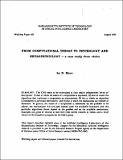| dc.contributor.author | Marr, David | |
| dc.date.accessioned | 2008-08-26T13:53:06Z | |
| dc.date.available | 2008-08-26T13:53:06Z | |
| dc.date.issued | 1976-08 | |
| dc.identifier.uri | http://hdl.handle.net/1721.1/41959 | |
| dc.description | This report describes research done at the Artificial Intelligence Laboratory of the Massachusetts Institute of Technology. Support for the laboratory's artificial intelligence research is provided in part by the Advanced Research Projects Agency of the Department of Defense under Office of Naval Research contract N00014-75-C-0643. | en |
| dc.description.abstract | The CNS needs to be understood at four nearly independent levels of description: (1) that at which the nature of a computation is expressed; (2) that at which the algorithms that implement a computation are characterised; (3) that at which an algorithm is committed to particular mechanisms; and (4) that at which the mechanisms are realised in hardware. In general, the nature of a computation is determined by the problem to be solved, the mechanisms that are used depend upon the available hardware, and the particular algorithms chosen depend on the problem and on the available mechanisms. Examples are given of theories at each level from current research in vision, and a brief review of the immediate prospects for the field is given. | en |
| dc.description.sponsorship | MIT Artificial Intelligence Laboratory
Department of Defense Advanced Research Projects Agency | en |
| dc.language.iso | en_US | en |
| dc.publisher | MIT Artificial Intelligence Laboratory | en |
| dc.relation.ispartofseries | MIT Artificial Intelligence Laboratory Working Papers, WP-131; | |
| dc.title | From Computational Theory to Psychology and Neurophysiology -- a case study from vision | en |
| dc.type | Working Paper | en |

